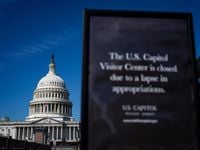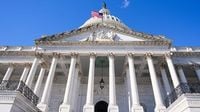After 40 days of gridlock, the United States government finds itself in the throes of its longest-ever shutdown—a crisis that has left 1.4 million federal workers unpaid, millions more Americans scrambling for food assistance, and Washington’s political class at a bitter impasse. The standoff, which began on October 1, 2025, has not only broken records but also tested the patience and resilience of ordinary citizens and lawmakers alike.
For Maria Garcia, a 57-year-old federal employee with 25 years of service, the shutdown has brought about a new and unwelcome reality. Forced onto unpaid leave, Garcia found herself queuing at a Maryland food bank for the second time in her life. “I’d never been to one, I never thought I would have to, but I’m here,” she told ABC News. She’s been forced to dip into her savings to cover her mortgage and bills, lamenting, “It’s upsetting, it’s sad that we have to be in this situation with this administration.”
Garcia’s story is echoed by countless others. Single mother Amy Flanery, also a federal worker, has managed to defer most of her payments so far, but the uncertainty gnaws at her. “If we don’t get paid again soon, those are going to run out and I don’t know how willing people are to keep deferring them because we’re still accumulating interest in the process,” she told ABC News. With a child in their senior year of high school, Flanery’s worries mount as expenses pile up.
The shutdown’s ripple effects have been felt far beyond individual households. According to ABC News and UPI, 42 million low-income Americans who depend on the Supplemental Nutrition Assistance Program (SNAP) have seen their aid thrown into jeopardy. SNAP funding ran out on November 1, forcing the Trump administration to tap contingency funds to keep the program afloat for a few weeks. Yet, as the days drag on, those lifelines are fraying. National parks remain shuttered, federal research has ground to a halt, and the air traffic control system is under increasing strain, with flight delays and cancellations mounting across the country.
Behind the scenes, the political stalemate has been fierce. Democrats in the Senate, wielding the filibuster, have blocked a House-passed GOP stopgap measure to reopen the government more than a dozen times. Their main demand: restore the expiring Obamacare subsidies that help millions afford health insurance. Republicans, holding 53 Senate seats—just shy of the 60 needed to break a filibuster—have insisted that health care negotiations can wait until after the government is funded. But trust is in short supply. “The Republicans made it clear they weren’t going to discuss the health care issue—the Affordable Care Act tax credits—until the shutdown was over. We tried to keep working that for six weeks. It didn’t happen,” Senator Angus King told ABC News.
Senator John Hickenlooper described the impasse in stark terms: “42 million people were being held hostage. ... They were threatened with hunger and starvation for the SNAP program.” The sentiment among many Democrats is that there’s “no good choice.” Hickenlooper added, “No matter what the courts said, he’s going to go back and fight it and tie it up forever. There’s no good solution.”
On November 9, 2025, the Senate eyed a procedural vote on a potential breakthrough deal to end the shutdown and fund the government through January 30, 2026. The proposed agreement features a temporary funding patch and a three-bill “minibus” to permanently fund military, veterans, and Department of Agriculture programs for the remainder of fiscal year 2026. Crucially, the minibus would fully restore SNAP funding, ensuring food aid for those 42 million Americans who have been caught in the crossfire.
Even so, the deal has drawn sharp criticism from prominent Democrats. Representative Ritchie Torres declared, “If this is the so-called ‘deal,’ then I will be a no. That’s not a deal. It’s an unconditional surrender that abandons the 24 million Americans whose health care premiums are about to double.” Democratic National Committee Vice Chair Malcolm Kenyatta echoed the sentiment, warning, “Any ‘deal’ that ends with Dems just getting a pinky promise in return is a mistake.”
Senate Majority Leader John Thune, for his part, has offered a December vote on extending the enhanced Obamacare subsidies, but he’s been candid about the uncertainty: “Can I guarantee an outcome? No. I can’t guarantee it’s going to pass,” he told MSNBC.
The shutdown’s economic toll is staggering. Estimates peg the cost at $14 billion, according to ABC News. Federal programs, national parks, and research initiatives have all been left in limbo. Meanwhile, the Trump administration has found creative—and controversial—ways to keep some parts of the government running. Service members have continued to be paid thanks to funds diverted from military research and, notably, a $130 million private donation from billionaire Timothy Mellon. This move has raised ethical questions about the influence of private money on public functions. Dartmouth Professor Dean Lacy noted, “It creates a government that’s not funded by the people but by special interests that are selecting what they want to fund. It looks like government is being turned over to private hands at times.”
President Trump’s actions during the shutdown have also drawn fire. While millions struggled, the president showcased White House renovations and hosted a lavish Great Gatsby-themed Halloween party. Professor Heather Evans of the University of Virginia called these moves “tone-deaf,” suggesting they were out of touch with the hardships faced by everyday Americans.
Public frustration has been mounting. An Economist-YouGov poll from late October found 58 percent of Americans disapproved of Trump’s handling of the presidency during his second term, the lowest net approval of his tenure. As Professor Lacy observed, “There’s a point at which pain will exceed partisanship, and Republicans will start to call their members of Congress and say, ‘Fix this now.’”
Despite the mounting pressure, the path to reopening the government remains fraught. Even if the Senate overcomes the filibuster, procedural hurdles could delay the process further. The House must still take up any deal before it can become law, and the president’s signature is required for final approval. There is also uncertainty about whether all federal workers will receive back pay. In 2019, retroactive pay was signed into law for all, but this time the Trump administration has suggested only those forced to work during the shutdown might be compensated—a prospect that has left many feeling abandoned.
Amid all the political maneuvering, it’s easy to lose sight of the human cost. As Professor Evans pointed out, those suffering cut across party lines: “They’re just Americans that vote left and right and they need help.” For now, millions wait anxiously, hoping Washington’s leaders can set aside their differences and bring the country’s longest shutdown to an end.






